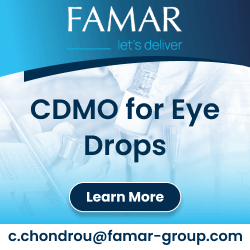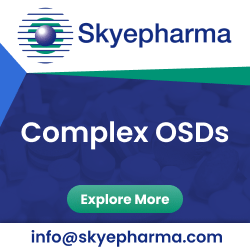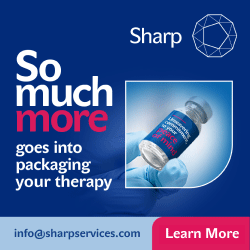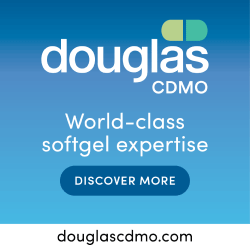Overview of ophthalmic formulation development & more on leading CDMOs offering formulation & manufacturing services for ophthalmic drug products.
Q1. What are ophthalmic drug products and what are the benefits?
Ophthalmic drug products are sterile solutions, semi-solid or solid preparations containing one or more active pharmaceutical ingredients (APIs). Ophthalmic formulations are intended to be used directly on the conjunctiva, conjunctival sac, or eyelids. Seldom, ophthalmic formulations are used to lubricate the eyes or to rinse out foreign bodies. These sterile products are applied mainly in the form of ophthalmic drops, ointments, gels, and emulsions to treat eye diseases.
Most ophthalmic products are simple homogenous solutions supplied in multi-dose plastic container closure systems (CCS) consisting of a bottle, a drug-dispensing tip, a cap, and an overseal or other tamper-evident features.
But the world of ophthalmics is not without its challenges. Physiological barriers such as precorneal factors and anatomical barriers, blinking and wash out by tears, nonproductive losses, impermeability of the cornea, and nasolacrimal drainage can hamper ocular delivery. Ophthalmic formulations must also be carefully balanced to ensure adequate bioavailability and minimal irritation, while maintaining sufficient quality control to gain regulatory approval.
The increasing prevalence of eye diseases is augmenting the demand for ophthalmic drugs, globally. In many developed and developing countries, eye conditions have already emerged as potential threats to visual perception. Antibiotics are popularly used in solution or ointment forms for the ophthalmic route of drug delivery to treat multiple ocular diseases (microbial keratitis, conjunctivitis, meibomian gland dysfunction, and dry eye).
Several contract manufacturing organizations (CMOs) or ophthalmic pharmaceutical manufacturing organizations offer contract services for ophthalmic finished dosage forms such as ophthalmic drops, emulsions, gels, lotions, ointments, suspensions, etc.
Various Advantages of Ophthalmic Drug Products:
- The most significant advantage of the ocular route of drug administration is that it ensures that the drug substance is available in higher concentrations than oral administration.
- Ophthalmic products are relatively simple to formulate, have minimal storage limitations, and ease drug instillation in most patients.
- Topical instillation enables direct delivery of the active pharmaceutical ingredient (API) onto the eye's surface.
- Ophthalmic products provide several advantages such as less irritation, increased precorneal residence time, and enhancement in ocular bioavailability of insoluble drugs in tear fluid.
- Ophthalmic formulations are compact and more manageable compared to pills or injections.
- An ophthalmic preparation offers accuracy and uniformity in dose rate by avoiding the pulsed doses of conventional systems.
- Lubricating eye drops, also called artificial tears, help relieve dryness and irritation and promote comfort by replacing the eye's natural moisture when eyes aren't making enough on their own.
- Artificial tears or lubricating eye drops promote surface healing, increase comfort by reducing the feeling of a surface scratch, and flush out any residual contaminating or harmful particles.
Q2. What are the types of ophthalmic formulations?
Ophthalmic formulations are specially designed to be applied to the eyes. The eye is a delicate organ and easily irritated if the composition of the ophthalmic formulation is not suitable. Ophthalmic formulations include numerous finished dosage forms such as liquid, semisolid, solid ophthalmic drug forms, and multicompartment drug delivery systems.
Various Types of Ophthalmic Dosage Forms:
1. Liquid Ophthalmic Dosage Forms:
Liquid ophthalmic preparations such as eye drops and eye lotions are prepared using aqueous vehicles. These dosage forms are required to be sterile, isotonic, and free from particulate matter.
- Ophthalmic Solutions
One of the most popular forms of ophthalmic finished dosage forms are ophthalmic solutions. Ophthalmic solutions are sterile, aqueous solutions, free from foreign particles, specially prepared for instillation in the eye.They enable the delivery of active pharmaceutical ingredients (API) directly onto the eye's surface.
- Eye Lotions
Eye lotions are sterile products used for washing eyes.This ophthalmic drug product has a soothing, antiseptic, or medicinal action when applied to the eye’s surface.
- Ophthalmic Suspensions
Ophthalmic suspensions are aqueous formulations that contain solid particles specially designed to be instilled into the external surface of the eye (topical). The particle size of ophthalmic suspensions typically must not exceed 25 µm to avoid eye irritation. In eye emulsions or suspensions, bioavailability depends on the particle size of the dispersed active pharmaceutical ingredient. In addition, overly coarse active ingredient particles can cause irritation in the eyes.
2. Semisolid Ophthalmic Dosage Forms
Semisolid finished dosage forms such as ointments, gels, and creams are applied to the eyelids' margin for therapeutic and protective action.
- Eye Ointments
Eye ointments are semisolid ophthalmic dosage forms for external use. Although eye ointments are well-tolerated and safe, they are best applied at night to relieve eye dryness and irritation because one’s vision may become blurred for a short while after using the ointment.
- Eye Gels
Eye gels allow patients to ease the ophthalmic application of a drop, with the enhanced benefits of increased viscosity. They permit the drug to contact the target tissues for a more extended period of time as compared to a traditional eye drop.
- Eye Creams
Eye creams are specialized semi-solid products meant to moisturize and tighten the skin under the eyes.
3. Solid Ophthalmic Finished Dosage Forms
Contact lenses coated with drugs, ocular inserts, SODI (soluble ophthalmic drug inserts), minidiscs/OTS (ocular therapeutic system), artificial tear inserts, collagen shields, etc. are the most prevalent forms of solid ophthalmic finished dosage forms. This drug form can easily be absorbed on the eye surface and is released after applying the drug over the eyeball for a more extended period of time.
- Ocular Inserts
Ocular inserts are defined as sterile, thin, multilayered, drug-impregnated, solid, or semisolid consistency devices placed into the conjunctival sac, whose size and shape are specially designed for ophthalmic application.
- Contact Lenses
Contact lenses can be used for ophthalmic applications to deliver pharmaceuticals to the eye. They ensure consistent and reproducible delivery of a drug substance. All contact solutions must be non-irritating or protect against microbial contamination during use and storage.
4. Nano Drug Delivery Systems for Ophthalmic Products:
- Microemulsions
Microemulsions (MEs) are isotropic, thermodynamically stable transparent (or translucent) oil, water, and surfactant systems. In addition, MEs as topical ocular carriers can lead to significant ocular drug adsorption due to their enhanced retention time. It has emerged as a promising strategy for the delivery of lipophilic and hydrophobic drugs. For ocular delivery, it provides several advantages such as excellent thermodynamic stability, a phase transition to liquid-crystal state, very low surface tension, and small droplet size, which may result in the improved ocular delivery of ophthalmic products.
- Liposomes
Liposomes, biodegradable and biocompatible nanocarriers consisting of a cellular membrane-like lipid bilayer surrounding an aqueous phase, represent an assuring avenue for ocular drug delivery. It enhances the permeation of poorly absorbed drug molecules by binding to the corneal surface and improving residence time.
CMOs for ophthalmic products or CDMOs with sterile product and aseptic processing capabilities may offer ophthalmic outsourcing services for ophthalmic finished dosage forms such as gels, lotions, creams, and ophthalmic suspensions.
Q3. What are the different points to be considered while formulating ophthalmic products?
There are various properties that one needs to scrutinize while formulating an ophthalmic product, for example, sterility, osmolarity, viscosity, pH, foreign matter, antimicrobial preservatives and wetting agents.
Some General Considerations for Ophthalmic Drug Products:
- Sterility
A sterile solution containing a particular pharmaceutical agent is administered to the external surface of the eye, usually in droplets. So, ophthalmic products and solutions must be manufactured under conditions authorized to render it sterile in its final container for the product's shelf life.
- Antimicrobial Preservatives
Antimicrobial preservatives are substances added to dosage forms to protect them from microbiological growth or from microorganisms that are introduced inadvertently during or after the manufacturing process.
- Osmolarity
Tear osmolarity is a function of the balance between the rates of tear production and tear loss from the eye. So, a tear’s osmolarity needs to be balanced by adequate tear production to maintain isotonicity. Thus, while formulating ophthalmic preparations, one should also focus on obtaining a precisely isotonic solution.
- Viscosity
The viscosity of a substance is characterized by its resistance to flow, so one must consider this factor while formulating any ophthalmic preparation. This enables the formulation to remain in the eye longer and gives more time for the drug to exert its therapeutic activity or undergo absorption. Viscosity enhancers, such as hydroxy methyl cellulose and hydroxyethyl cellulose are used in ophthalmic products to increase viscosity.
- pH
One unique challenge of ophthalmic formulation development is that of pH. It is essential to maintain the pH of all complex dosage forms to optimize the stability and bioavailability of their APIs. The pH and buffering capacity of solutions, eye drops, ophthalmic suspensions, and in situ gels play a significant role in proper preservation since the stability of the most commonly used ophthalmic drugs are controlled mainly by the pH of their environment. In addition to stability effects, pH adjustment can influence the product's comfort, safety, and activity. Therefore, it is essential to maintain optimum pH for ophthalmic products and solutions.
- Foreign Particles
Foreign objects and debris in the eye usually affect the cornea or conjunctiva. So, while formulating ophthalmic products and solutions, one should ensure that ophthalmic preparations are clear and free from foreign particles, fibers, and filaments.
- Wetting Agents
A wetting agent is a surface-active molecule used to reduce surface tension. The high surface tension of water is problematic in many applications where spreading and penetration of water is required. It is essential to ensure that ophthalmic formulations have an excellent wetting ability to penetrate the cornea and other tissues.
Contract manufacturing organizations or ophthalmic pharmaceutical manufacturing organizations with thorough experience and expertise in finished dosage forms, sterile products and aseptic processing can handle the challenges associated with ocular drug delivery. In addition, these organizations enable ophthalmic outsourcing of formulation development and sterile manufacturing services for ophthalmic drug products and other complex dosage forms.
Q4. What are some types of ocular excipients?
An ophthalmic product is more excipient than an active pharmaceutical ingredient, which symbolizes that added ingredients are an integral part of such formulations. The characteristics of excipients are multifaceted, allowing them to perform more than one critical function.
Ocular excipients include ointment bases, gelling agents, chelating agents, solubilizers, preservatives, cheating agents, etc. On the other hand, using other constituents such as color, odor, or flavor is strictly prohibited.
Some Types of Ocular Excipients:
- Ointment Bases
Ointment bases are mixtures of fats, waxes, animal and plant oils, and solid and liquid hydrocarbons, which act as vehicles for medicinal substances intended for external application. Primarily, petrolatum is the base used for most ophthalmic formulations, giving them a characteristic “gooey, sticky” feeling.
- Gelling Agents
Gelling agents function as thickeners to provide thickening without stiffness at a concentration of 0.5%–10%. Examples of gelling agents include tragacanth, pectin, starch, sodium alginate, gelatin, etc. which have been used in sustained-release ocular formulations.
- Solubilizers
Other than drug preservatives, bases, and gelling agents, sometimes one may need to add co-surfactants or co-solvents in ophthalmic preparations. A solubilizing agent acts as a surfactant and increases the solubility of excipients. For instance, ethanol, glycerin, and propylene glycol are added to formulations because of their osmotic effect on neighboring tissues.
- Preservatives
Preservatives are substances (natural or chemical) that are added to pharmaceutical products to prevent any kind of physical, chemical, or biological changes. Besides, preservatives are effective antimicrobial and fungicidal agents that help minimize organism growth in multi-dose containers. Benzalkonium chloride is a quaternary ammonium disinfectant and antiseptic. It is considered as a preservative of choice for most multi-dose aqueous nasal, ophthalmic, and otic products at a 0.01–0.02% concentration.
- Chelating agents
A chelating agent is a chemical compound that reacts with metal ions to form stable, water-soluble metal complexes. Thus, chelating agents such as edetate disodium (EDTA) and stabilized oxychloro complexes are consolidated into ocular drug products for stability purposes.
Q5. Which are the leading pharmaceutical CDMOs offering ophthalmic formulations?
Several pharmaceutical organizations, including ophthalmic CDMOs or a CMO for ophthalmic products, equipped with ophthalmic formulation and manufacturing facilities, may offer contract development and manufacturing services, ophthalmic formulation development, clinical trial materials, etc.
Leading CDMOs and CMOs that offer ophthalmics outsourcing have thorough experience and expertise in sterile products and aseptic processing. Some of them and the formulation and manufacturing services or drug product services they offer are noted below.
Leading Pharmaceutical CDMOs Offering Ophthalmic Formulations:
Fareva - Ophthalmic Formulation Development
Fareva is an ophthalmic CDMO that offers contract development and manufacturing services for sterile ophthalmic (semi-solid and liquid) and sterile injectable preparations. They can handle the processes under the specific constraints associated with ophthalmic solutions and sterile and injectable products.
Besides, all their production sites have the necessary equipment for serialization and to ensure the inviolability of drugs. Fareva has 5 R&D centers for pharmaceutical projects, including clinical trial material manufacturing, pharmaceutical development, analytical method development, and scale-up.
Recipharm - Ophthalmic Formulation Development
Recipharm offers a range of ophthalmic drugs contract manufacturing and drug product services. Its site in Lisbon performs sterile manufacturing of eye and ear drops filled into plastic multi-dose containers. Recipharm’s Kaysersberg site provides customers with single-use ophthalmic preparations by employing blow-fill-seal technology.
Eurofins - Ophthalmic Formulation Development
Eurofins CDMO offers contract development and manufacturing services for a wide range of drug delivery routes and drug delivery systems, including ophthalmics, oral liquid and solid formulations, parenteral formulations, topicals, buccal delivery, pulmonary delivery, etc.
Hence it serves as CMO for ophthalmic products. Furthermore, its cGMP manufacturing plant provides highly potent API handling and other contract services, such as formulating new chemical entities or reformulating existing drugs, including biosimilars.
Unither - CDMO for Ophthalmic Formulations
Unither Pharmaceuticals is the world's number one company which offers drug product services for the production of BFS products. Blow-fill-seal single doses are ideal drug delivery solutions for use in ophthalmology, otic care, inhalation therapy, and wound care. In addition, Unither’s contract services include clinical trial material as well as formulation and manufacturing services.
Zenvision Pharma - CMO for Ophthalmic Products
Zenvision Pharma is a CMO for ophthalmic products, offering a full range of custom-designed formulation and manufacturing services with professional standards. They are committed to innovation and deliver ophthalmic drug contract manufacturing services. Their core services include the development of topical, including semi-solid and liquid forms, ophthalmic and otic, and parenteral formulations, along with clinical trial materials services.
All Suppliers
















 AbbVie CDMO has been working with global companies to develop, manufacture & scale biopharmaceutical products.
AbbVie CDMO has been working with global companies to develop, manufacture & scale biopharmaceutical products.







